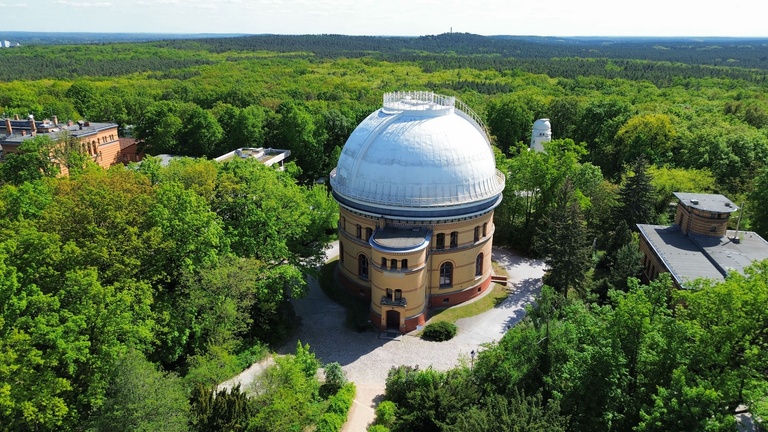Potsdam, Germany, August 18, 2025. The year 2024 was the warmest year since records began – and the first to exceed 1.5°C above pre-industrial levels for the annual global average temperature.[i] Extreme heatwaves and long-lasting periods of drought are on the increase. Even Telegrafenberg in Potsdam is not unaffected. Due to the heat and drought, around 78 percent of the trees on the site are considered damaged. To make the long-established center of science ready for the future, Drees & Sommer has been entrusted by the GFZ Helmholtz Centre for Geosciences with the development of a comprehensive landscape plan. The company has its headquarters in Stuttgart and specializes in advice on construction, real estate and infrastructure.
The Telegrafenberg hill in Potsdam is a place of special significance: the 27-hectare park-like site is home to renowned research institutes, such as the GFZ Helmholtz Centre for Geosciences and the Potsdam Institute for Climate Impact Research (PIK), with a tradition that goes back around 150 years. Many of the large trees that grow here are at similar age or even older. Dr. Knut Kaiser, Sustainability Manager of GFZ comments: “We have been observing the consequences of climate change at this location for years now. The trees in particular are suffering more and more from rising temperatures. The new landscape plan aims to preserve the Telegrafenberg hill as a green space. For example, we are implementing measures for climate adaptation, biodiversity and a stable water balance, while also ensuring the long-term attractiveness and functionality of the campus.“
Diverse Habitats as Ecological Potential
The species-rich vegetation on the Telegrafenberg hill forms the basis for a diverse ecosystem. "A wide range of features, from sparse pinewood and sandy grassland to close-to-nature woodlot, creates valuable habitats for a variety of animal and plant species.
Particularly noteworthy are two clusters of lily-of-the-valley, which are not only visually striking when they blossom in springtime, but are also ecologically significant,” says Ramona Giese, Drees & Sommer’s expert in water and climate issues, who heads the project. Observations of peacock butterflies, woodpeckers, common cockchafers and the rare Klaiber lizard species illustrate the nature conservation value of the area. In addition, various species on the early warning list or Red List have been detected. An especially noteworthy aspect is that, starting from 'mother trees' planted in the former observatory at the end of the nineteenth century, a yew stand of around 2,000 mostly younger individual trees has developed here over the course of a century. It is one of the largest distributions in north-east Germany.
Holistic Planning for a Climate Resilient Research Campus
As an important cold air lane, the Telegrafenberg hill makes a significant contribution to improving the urban climate in Potsdam. It acts as an important infiltration area for rainwater, and borders directly on countryside and drinking water conservation areas. “The diverse tree vegetation takes up a large part of the site and is seriously endangered. In order to counteract this and prepare the location for the challenges of climate change, a comprehensive survey is required first,” Drees & Sommer’s expert explains. This includes an analysis of the terrain’s historical development, a geobotanical study of the current vegetation and an assessment of the land use.
Ramona Giese and her team at Drees & Sommer will also analyze the capacity of the soil for water and nutrient storage. The aim is to minimize the risk of vegetation fires, examine the sustainable use of biomass and ensure the long-term health of the woodland. “The trees are increasingly lacking water due to rising temperatures and longer periods of drought. They dry out and die,” says Ramona Giese. A major focus of the analysis is on developing the existing rainwater concept. The aim is to develop measures so that rainwater can seep away more efficiently, or be collected and used – to improve ecological resilience, for example, and avoid the consequences of heavy rainfall.
A Look into the Digital Crystal Ball
To ensure that water management works effectively going forward, Ramona Giese relies on a wide range of analytical tools: “The Scalgo geoinformation system can be used to visualize surface runoff and simulate potential flooding risks, for example.” In this regard, the experts are examining various approaches for further development of the existing decentralized rainwater management. A particular focus is on making greater use of the available water resources.
Combining Opposites
“Our objective is to preserve the green campus. This means reconciling apparent opposites: the conservation of historical structures with the necessary adaptation to climate change, the careful maintenance of the facilities with the protection of biodiversity, and the demands arising from usage with the preservation of sensitive vegetation,“ points out Dr. Knut Kaiser of GFZ. The development of the landscape plan and the analyses by Drees & Sommer are scheduled to be completed by April 2026.
[i]www.copernicus.eu/en/news/news/copernicus-global-climate-report-2024-confirms-last-year-warmest-record-first-ever-above
